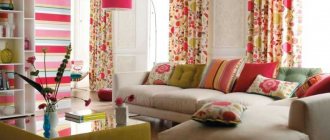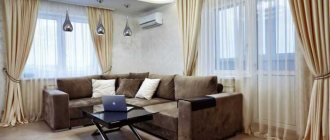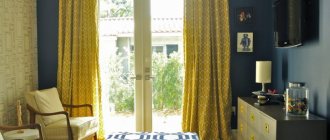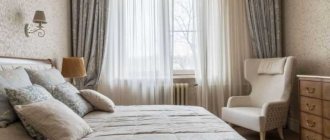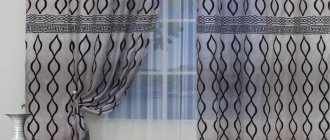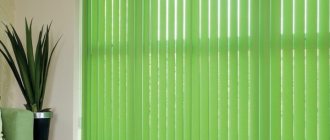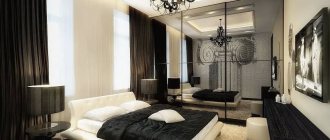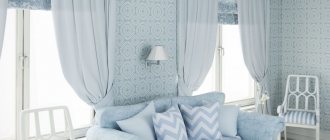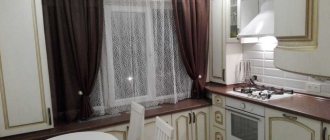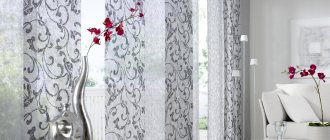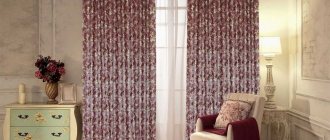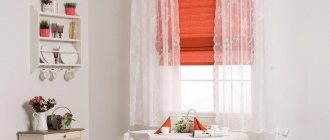Lush Viennese (Austrian) curtains fit into the interior of apartments, offices, and large halls. The curtains, decorated in an elegant style, gather in graceful folds. When lowered, the curtains become rectangular sheets and take up minimal space in the window area.
What are Viennese curtains
Curtains in a similar style appeared in the 18th century. The principle of operation came from Roman curtains, and the elegant appearance from French curtains. The products are a rectangular sheet attached to a cornice. Cords run vertically along the entire length of the material, with the help of which the fabric can be gathered into folds and scallops or raised.
Difference from French curtains
Austrian curtains are a flat fabric gathered along the bottom edge. This is their main feature. When raised, the straight fabric gathers into lush tails. The material consumption for sewing such products is economical.
French curtains have voluminous folds running along the entire length of the fabric. When collected they are lush, but when lowered they are soft and wavy.
Fabric texture and pattern
Curtains for the kitchen should allow light to pass through, not create a feeling of heaviness, be easy to drape and be easy to care for. Therefore, loose, translucent fabrics that are resistant to stains and can withstand numerous washes are suitable for them. These can be cotton fabrics with a small addition of synthetics: linen, satin, cambric, as well as tulle, veil, organza and their various modifications.
As for colors, it is recommended to give preference to fabrics painted in plain, natural tones, or with small patterns: small floral patterns, checkered patterns, polka dots, thin horizontal or vertical stripes.
You should not choose prints with large patterns, since numerous folds and scallops will still distort or hide it.
Suitable fabrics
For tailoring, soft, well-draped materials are selected. They can have different densities and ability to transmit light. When choosing fabrics, it is important to take into account the style of the interior, the overall color scheme and the direction of the world on which the windows face.
Tulle
The translucent material drapes easily and lets in a lot of light. Viennese curtains made from this fabric are complemented with classic curtains or lambrequins.
Veil
The rare-woven mesh fabric drapes beautifully, allowing you to create graceful folds. The lower edge of curtains made of this material is decorated with lace, glass beads, and hand stitching.
Organza
Thin translucent fabric is stiffer than tulle. It is assembled into voluminous, breakable folds, thanks to which curtains made from it fill the room with light and give it a special charm.
Guipure
Openwork material is chosen for sewing Viennese curtains if it is necessary to focus attention on the windows. It is decorated with tassels or fringe, giving the interior a solemn look.
Linen
The natural material forms uniform deep folds. It protects the room from prying eyes and excess sunlight.
Velours
Viennese curtains made of this material give the interior a solemn look and are used when decorating windows in large rooms. They are complemented with tassels, lambrequins, cords, and fringe.
Austrian curtains for the kitchen: lightness, convenience, charm
When choosing curtains for the kitchen, you should pay attention not only to the appearance of the product, but also to its functionality. Curtains must be adjustable, because the kitchen is often busy with work, and sometimes you just need to adjust the curtains.
Now on the market you can find many different curtain options that have functional advantages. These include blinds that change their position if you pull a thread, or roller blinds that can be rolled into one roll; such curtains can rise, practically disappearing from view, which is very convenient. But they also have a drawback - external characteristics. Such products look very simple, literally dry. They have no decorations, are made, most often, of plastic, their shape is primitive, so lovers of style and sophistication often avoid such options. And this is not without reason, because you can find more attractive curtains that will be convenient to use in the kitchen and their appearance will delight you all year round.
Austrian curtains are notable for the fact that they have a working mechanism that allows for lifting and lowering manipulations, but at the same time the curtains have an attractive appearance.
Such curtains appeared many years ago, back in the 18th century. They came from a combination of Roman and French curtains. From the first they got the appearance, from the others the operating principle.
Device
Austrian curtains are a straight linen that is attached to a curtain rod. A special cord is passed vertically through the entire length of the curtains, which allows you to collect the curtains upward. This technology can be used by opening a window, letting daylight into the room, and also to decorate them.
The working mechanism is based on a chain that has the property of self-braking, which is very convenient. After all, in order to give the product the desired position, you do not have to touch it with your hands; it will be enough to manipulate the chain.
This technology is very beneficial for the kitchen because it is easily adjustable. If you need more light while cooking but your hands get dirty, you can easily adjust the position of the curtains without touching them. Later, you can wash the adjustment area, and this is much faster and easier than washing the entire curtain.
Previously, in ancient times, these curtains were not used to regulate the level of lighting in the room, but simply for decoration. They were most often located on windows that were closed with shutters, so the curtains served primarily a decorative purpose.
Currently, this trend has partially continued. Austrian curtains act as a decorative element. Nowadays these curtains come in a wide variety; very often you can find models made of light translucent material that allows light to pass through. Many people may wonder: why do we need curtains that do not protect from the sun? The answer is very simple - such curtains are located in a room where there is no need to prevent light from entering. Now we are talking about such a room as a kitchen.
There really is no need to hang massive thick curtains that would protect the room from excessive light, because this function is in demand mainly in bedrooms and living rooms where people relax and sleep.
No one sleeps in the kitchen, therefore, there is no need for thick curtains, and light translucent curtains can be placed there. Silk models would be an excellent option. They look light and casual, especially if they have a soft color. Such curtains will delight any housewife.
Color solutions
These curtains can be made in any color. This applies to curtains made of any material. Very often you can find models that are characterized by bright colors. Now it's stylish and modern. Such curtains are suitable for connoisseurs of the new and perfect.
If you decide to purchase Austrian curtains because you like the classic style, then you should pay attention to the option in calm, soft colors. Soft beige, white, peach options will be very good. Austrian curtains are characterized by their folds and folds, which are reminiscent of the classics in style. Such curtains will complement and decorate any interior.
These curtains will be an excellent choice for the kitchen or dining room, because they are practical and stylish. Curtains can be matched to any interior design of the room. Light and charming Austrian products will delight any housewife, giving the room a cozy atmosphere.
Suitable interior styles for application
Austrian-style curtains are used to decorate rooms in classic and modern styles. In combination with the rest of the decoration, they help set accents and give the room a well-groomed look.
Provence
For an interior in this style, samples made of simple linen fabrics with a checkered, striped or floral pattern are suitable. Such curtains maintain the overall atmosphere and refresh the look of the room.
Vintage
When decorating windows in the interior of such a room, Viennese curtains made of flowing materials in the spirit of old times (brocade, velvet, velor, silk, taffeta) are used.
The main task is to choose the length and shade of the curtains and form the drapery.
Classical
Austrian-style curtains are used to decorate windows in large rooms. They are made from translucent materials, the light drapery of which looks sophisticated.
Modern
These curtains add a touch of chic to a modern setting. They are sewn from thin transparent fabrics that give the room lightness.
American
Austrian curtains made of opaque materials with small ornaments or geometric patterns will allow you to emphasize the neatness and presentability inherent in this style.
They can have a simple cut and barely visible drapery along the edge.
Austrian curtains made of thick fabrics
Austrian scalloped curtains made from dense fabrics, combined with classic interiors, create a dramatic and glamorous look in the premises.
The modular width and adjustable height of the curtains, from straight lifting to the formation of hanging multi-row scallops, create different visual effects.
Note!
French curtains - features of French curtains. Characteristics of structures and fastenings, choice of fabrics and colors for curtains (photo + video)- Double curtains - TOP 120 photos and videos of double curtain design options. Types of installations, designs and materials of double curtains
Greek curtains: features of the design and installation of Greek curtains. Selection of fabric in the Greek style, variety of colors and textures (photo + video)
Fabric colors
When choosing a pattern and color of a material, it is important to take into account the features of the interior, the area of the room and the degree of its illumination. It is not necessary to use plain fabrics.
With flowers
Flowers on the curtains soften the atmosphere and bring a feeling of celebration. Light and sophisticated designs create a joyful and soulful atmosphere in the interior.
Floral patterns
When decorating windows, designers often use curtains with fashionable patterns. The canvases contain curls, vines, leaves, petals and other natural elements.
Ornaments
Original drawings focus attention on the windows and transform any room. Viennese curtains with patterns add sophistication and charm to the simplest furnishings.
Geometry: stripe, check
Curtains with clear geometric patterns add laconicism and rigor to the decor. They are appropriate in living rooms, offices, and kitchens. Light draperies and waves along the edge soften the overall appearance.
Photos of Austrian curtains
Read here Modern curtains: 140 photos of fashion trends in interior design
Did you like the article? Share 
Design and decor options
The products require a cornice with a lifting mechanism. They come with tight cords that are attached from the inside out and ensure uniform drapery.
Multilayer
Such curtains are created from several canvases that are harmonious with each other in shade and design. A popular combination of thick and translucent fabric, complemented by a lambrequin and draperies.
On bows
In this interpretation, the fabric flows freely, and the drapery is decorated with beautifully tied bows. By fixing the folds, they give the window decor a festive look.
Lace
The use of openwork elements brings warmth and lightness to the interior. Austrian curtains decorated with lace are usually combined with thicker types of curtains.
With bugles
Fittings and fringe with glass elements are used to give the room a light and glamorous look. Such fittings are combined with accessories made of crystal and Swarovski crystals.
From threads
Elegant and thin, like a cobweb, canvases allow you to create interesting decorative solutions. Such curtains look especially impressive in the decoration of living rooms and restaurant halls.
Mounting options for cornice
There are several options for attaching Viennese curtains:
- to the ceiling;
- wall above the window;
- cornice;
- frame;
- slope above the window.
Curtains can come complete with a curtain rod equipped with a closed or open lifting mechanism.
Velcro
To hang light canvases on the cornice strip, fastening with Velcro tape is used. It consists of soft and hard parts and is attached to a window, wooden plank or wall. When fixing to the cornice, loops are used.
With strings
Curtains with loops and ties look original in the interior. Curtains are secured to the curtain rod using cords, ribbons or textile strips, which are tied with a bow or beautiful knots.
Master class on sewing Austrian curtains with your own hands
Before work you should prepare:
- sewing machine;
- scissors;
- threads matching the color;
- base for curtains;
- braid or tightening tape;
- nylon cord;
- curtain tape.
Lining fabric is required if necessary.
Choice of fabric and design
If priority is given to pronounced folds, emphasized shapes and accentuated flounces, you should purchase dense, smooth fabrics (satin, linen, satin). When smooth, wavy transitions are needed, you should focus on flowing fabrics (silk, velor, tulle).
How to determine dimensions
The width of the finished product should be 2 times the length of the cornice. The dimensions of the model are calculated by their location on the window. The length of the product is calculated depending on how the curtain will hang. If the curtain is straight when lowered, it is equal to the distance from the cornice to the floor.
When determining the length of the cord, the number of gathering strips is multiplied by the size of the fabric allocated for folds. Take into account how much the cord will exceed the edges of the fabric. The resulting values are added and multiplied by the number of stripes.
Step-by-step instruction
Before cutting, you should familiarize yourself with the drawing of the curtain, and also steam the prepared fabric.
Main stages of sewing:
- Cut a piece of fabric of the required size, taking into account allowances.
- Using the pattern, mark with chalk where the curtain tape goes.
- Topstitch the side hem.
- Hand sew the braid into place.
- Fold the fabric over 5 cm and stitch.
- Attach a ribbon along the seam for hanging.
- Turn it inside out and stitch.
- Process and decorate the bottom edge according to the design plan.
- After each line, iron the fabric.
On the finished product, carefully tighten the tape and secure the cords. Assembly will be facilitated by a lifting mechanism that is inserted from the side and attached to the top of the cords.
Curtains made from ready-made curtains
Using the principle described above, you can alter curtains from old curtains. It is recommended to decorate them with fringe, bows or braid.
An easy way to drape Austrian curtains
A modern way to give Viennese curtains an attractive look is to use drapery tape. It is sewn on the sides of each row of folds. The braid can be carefully tied and periodically unraveled, resulting in a smooth fabric.
Sewing stages
Let's consider creating a simple version of Austrian curtains, without a second layer of purl fabric, darts and other complicating details.
- We cut a piece of fabric of the required size, and be sure to steam it first. This is necessary so that possible shrinkage after the first wash does not spoil the appearance of the curtain.
- Next, you need to mark with chalk the places where the curtain tape will be laid to create folds. For this we use a pattern made in advance or, if you have some sewing experience, apply the markings directly to the canvas.
All seams must be ironed carefully
- Then we sew off the side fold. Its value depends on the type of fabric chosen. As a rule, leave 3 cm on dense material, 2 cm is enough on thin and weightless material.
- Using a basting stitch, we manually sew the ribbon strips into place. Those of them that are located at the edges are sewn as close to the hem as possible.
- We iron everything with an iron and only then attach the braid to the curtain fabric.
Important! The upper part of the Austrian curtain is flat, it does not drape or gather in folds. Therefore, it is not always worth sewing the gathering tape along the entire length. This may be necessary if you plan to frequently change the position of the curtain or purchase a special lifting mechanism or clamps.
- The next step is to decorate the top of the product. To do this, fold 5 cm onto the wrong side of the fabric and sew a seam on a sewing machine with threads exactly matching the fabric tone.
- We sew the curtain tape for the top (the width of the standard tape is 6 cm) from the front side along the previously made seam.
- Turning the tape inside out, attach it again. After these manipulations, only one smooth and neat seam will be visible on the front side.
- After each line laid on the machine, be sure to iron it well. Only after such heat treatment will the product have a neat appearance, without curling or gathering unnecessary folds.
Austrian curtains in the interior
All that remains is to design the bottom edge as you wish. Depending on the idea, you can sew on any decorative elements. Then carefully tighten the curtain braid, achieving the desired density of the folds, and fix the cords. Curtains with weights hang straighter and look aesthetically pleasing. Such weights are sewn at the bottom of each assembly tape.
Making Austrian curtains with your own hands may require effort, patience and accuracy. But as a result, the craftswoman will receive a completely exclusive product, made exclusively to her taste and needs. A room with such curtains will reflect the features of the bright personality of its owner.
Austrian curtains: video
Austrian curtains in the interior: photo
In which rooms can you use photos in the interior?
Viennese-style curtains fit effectively into almost any living space, including offices and bathrooms. Photos of the interiors will allow you to verify this.
In the living room
In rooms with large windows, brightly colored curtains can be used as an accent. A combination with tulle will help emphasize the richness of the cut and material.
In the bedroom
Curtains made of pastel-colored fabrics will create a romantic atmosphere. They will be complemented by translucent flowing curtains.
In the nursery
Light tulle with cheerful patterns is suitable for a preschooler's nursery. At an older age, girls are given fabrics in pastel shades, decorated with fringe and lace. The solution for boys is curtains in calm colors.
In the kitchen
The optimal length of curtains is up to the window sill. When choosing the type of fabric, you should prefer synthetics: it absorbs odors less and is resistant to stains.
In the office
Austrian curtains in a classic style are selected for work spaces and business offices. Dark, soft colors and lack of decor are preferred.
In public places
Viennese style is a suitable idea for decorating restaurant halls and marriage registrations, theater foyers, dining rooms and other public places. When holding corporate events, it is appropriate to decorate windows with silk curtains and veils.
Curtains in interiors
Traditional flat and pleated Roman and Japanese blinds are used in the interiors. Roller blinds are also gaining popularity. If the interior is made in a classic style, then the windows are decorated with exquisite Austrian curtains.
Sewing Austrian curtains with your own hands is not difficult if you have experience working with a sewing machine.
Application options for non-standard shaped windows
Window openings of unusual shape (rectangular, arched, bay windows) are a bright accent of the interior. When decorating them with the help of Austrian curtains, original solutions are used.
On an arched window
Viennese curtains are used to decorate arched windows of any shape. The main task is their correct installation and compliance of the design with the overall concept of the room.
Bay window
When decorating windows located in a room that extends beyond the plane of the facade, you should choose multi-layer curtain options. A good solution is a combination of thick curtains with Viennese curtains made of translucent fabric in suitable shades.
Window with balcony door
The use of fabrics of different densities allows you to hide the exit to the balcony and at the same time let in enough light. The structure is made according to the size of the opening.
On the windows along the stairs
Tall windows along staircases in palaces, cottages and other spacious rooms are highlighted using asymmetrical compositions. When decorating, light and elegant materials are used, which give the atmosphere a solemn and pompous look.
Austrian curtains for a romantic bedroom
The decor for bedroom windows should shade the room as much as possible to ensure a comfortable and restful sleep. The soft folds of Austrian curtains can provide the necessary twilight during daytime rest and prevent the penetration of moonlight and street lamps at night. Translucent tulle will not work as the main curtain; natural dense fabrics are needed. Or install blinds on the windows or additionally hang thick curtains.
Austrian curtains in the bedroom interior
The opinion that Austrian curtains are suitable for a child’s or girl’s room is erroneous. The men's bedroom will be perfectly complemented by Viennese curtains made of fabric with a dense texture. The color scheme for coffee with milk or khaki and sculptural festoons will emphasize the brutality of the interior.
Austrian curtains in the bedroom
For a family bedroom, soft pastel shades to match the rest of the decor and furniture are suitable. In the relaxation room, there should be no color contrast between the curtains and other details. Fans of bright colors can add a couple of “screaming” elements: red cords or rich green tassels on light translucent tulle, or rich blue fringe on pale blue scallops.
Beige Austrian curtains in the living room
Window design in interior design is considered to be an important detail, since it is the only element that is available to everyone. Therefore, special attention should be paid to the selection of curtains and you should not cover the window opening with a simple silk curtain. Often, an expensive and elegant design is spoiled by poor-quality fabric on the curtains or an ineptly chosen window decor style.
Red and white Austrian curtains in the bedroom
